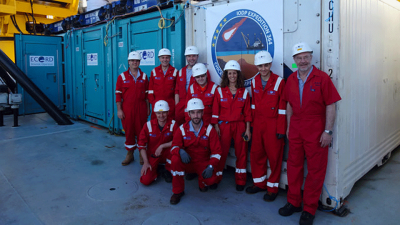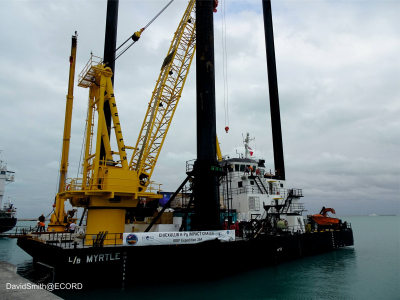Page path:
- Home
- Discover
- Media Releases
- Media Releases 2016
- 18-04-2016 International expedition to the Chic...
International expedition to the Chicxulub impact crater
Led by Co-Chief Scientists Sean Gulick, University of Texas at Austin in
the United States and Joanna Morgan, Imperial College London, United
Kingdom, and co-ordinated in Mexico by Jaime Urrutia-Fucugauchi from
the National Autonomous University of Mexico (UNAM), the team will
collect cores from a single drill site at a water depth of 17 metres. The plan
is to collect cores as deep as 1500 metres below the seafloor to recover
rocks from above and into the Chicxulub impact crater.
“Peak rings are a common feature of large craters”, said Gulick, a marine
geoscientist “But there is no consensus on their formation. This expedition
will help us to understand how the asteroid impact temporarily changed
the rocks behaviour allowing them to flow large distances and form
features such as a peak ring”.
“We will also study the possibility that asteroid impacts may be beneficial
to some forms of life as there is a hypothesis that impact craters could
have sustained biospheres in the early Earth’ said Morgan, also a marine
geoscientist. “We are also interested in the changes that occurred before
and after the impact and how life recovered in the ocean”
“We are also interested in the changes that took place across what’s
known as the Paleocene-Eocene Thermal Maximum, which occurred 10
million years after the impact event” said Ligia Perez-Cruz,a geoscientist
at UNAM.
Overall the expedition aims to study:
• The rocks that form the peak ring. For example, are they
from the Earth’s upper mid or lower crust?
• Habitability: Was there intense hydrothermal activity in the
rocks that form the peak ring and how long did it last? What
microbiological life colonized the peak ring? Was it diverse
and/or exotic, and was it shaped by the post-impact
hydrothermal system?
• Recovery of life: After the impact, how long did it take for the
ocean to return to normal conditions? Did diversity gradually
recover, or did the whole assemblage return simultaneously
once the environment stabilised? What is the relationship
between the survivors of the impact event and newly evolved
taxa.
The expedition is conducted by the European Consortium for Ocean
Research Drilling (ECORD) as part of the International Ocean Discovery
Program (IODP). The expedition is also supported by the International
Continental Scientific Drilling Programme (ICDP). The expedition would
not have been possible without the support and assistance of the Yucatán
Government, Mexican federal government agencies and scientists from
the National Autonomous University of Mexico (UNAM) and the Centro de
Investigación Científica de Yucatán (CICY).
Media features on the expedition:
the United States and Joanna Morgan, Imperial College London, United
Kingdom, and co-ordinated in Mexico by Jaime Urrutia-Fucugauchi from
the National Autonomous University of Mexico (UNAM), the team will
collect cores from a single drill site at a water depth of 17 metres. The plan
is to collect cores as deep as 1500 metres below the seafloor to recover
rocks from above and into the Chicxulub impact crater.
“Peak rings are a common feature of large craters”, said Gulick, a marine
geoscientist “But there is no consensus on their formation. This expedition
will help us to understand how the asteroid impact temporarily changed
the rocks behaviour allowing them to flow large distances and form
features such as a peak ring”.
“We will also study the possibility that asteroid impacts may be beneficial
to some forms of life as there is a hypothesis that impact craters could
have sustained biospheres in the early Earth’ said Morgan, also a marine
geoscientist. “We are also interested in the changes that occurred before
and after the impact and how life recovered in the ocean”
“We are also interested in the changes that took place across what’s
known as the Paleocene-Eocene Thermal Maximum, which occurred 10
million years after the impact event” said Ligia Perez-Cruz,a geoscientist
at UNAM.
Overall the expedition aims to study:
• The rocks that form the peak ring. For example, are they
from the Earth’s upper mid or lower crust?
• Habitability: Was there intense hydrothermal activity in the
rocks that form the peak ring and how long did it last? What
microbiological life colonized the peak ring? Was it diverse
and/or exotic, and was it shaped by the post-impact
hydrothermal system?
• Recovery of life: After the impact, how long did it take for the
ocean to return to normal conditions? Did diversity gradually
recover, or did the whole assemblage return simultaneously
once the environment stabilised? What is the relationship
between the survivors of the impact event and newly evolved
taxa.
The expedition is conducted by the European Consortium for Ocean
Research Drilling (ECORD) as part of the International Ocean Discovery
Program (IODP). The expedition is also supported by the International
Continental Scientific Drilling Programme (ICDP). The expedition would
not have been possible without the support and assistance of the Yucatán
Government, Mexican federal government agencies and scientists from
the National Autonomous University of Mexico (UNAM) and the Centro de
Investigación Científica de Yucatán (CICY).
Media features on the expedition:
- http://www.nature.com/news/geologists-to-drill-into-heart-of-dinosaur-killing-impact-1.19643
- http://www.sciencemag.org/news/2016/03/scientists-gear-drill-ground-zero-impact-killed-dinosaurs
- http://www.bbc.com/news/science-environment-35950946
- http://www.bbc.com/news/science-environment-35953976
- http://www.dailymail.co.uk/sciencetech/article-3480222/Searching-life-mass-extinction-Scientists-plan-drill-crater-left-asteroid-killed-dinosaurs.html
- http://www.i24news.tv/en/news/technology/108474-160404-ashes-to-algae-how-the-asteroid-that-wiped-out-life-could-have-helped-revive-it
Contact/Interviews/Images:
Alan Stevenson
British Geological Survey
Edinburgh/UK Institute of Geophysics
Email: [Bitte aktivieren Sie Javascript]
Phone: +44 131 650 0376
Ulrike Prange
MARUM Science Communication
Phone: +49 421 218 65540
Email: [Bitte aktivieren Sie Javascript]
Alan Stevenson
British Geological Survey
Edinburgh/UK Institute of Geophysics
Email: [Bitte aktivieren Sie Javascript]
Phone: +44 131 650 0376
Ulrike Prange
MARUM Science Communication
Phone: +49 421 218 65540
Email: [Bitte aktivieren Sie Javascript]





